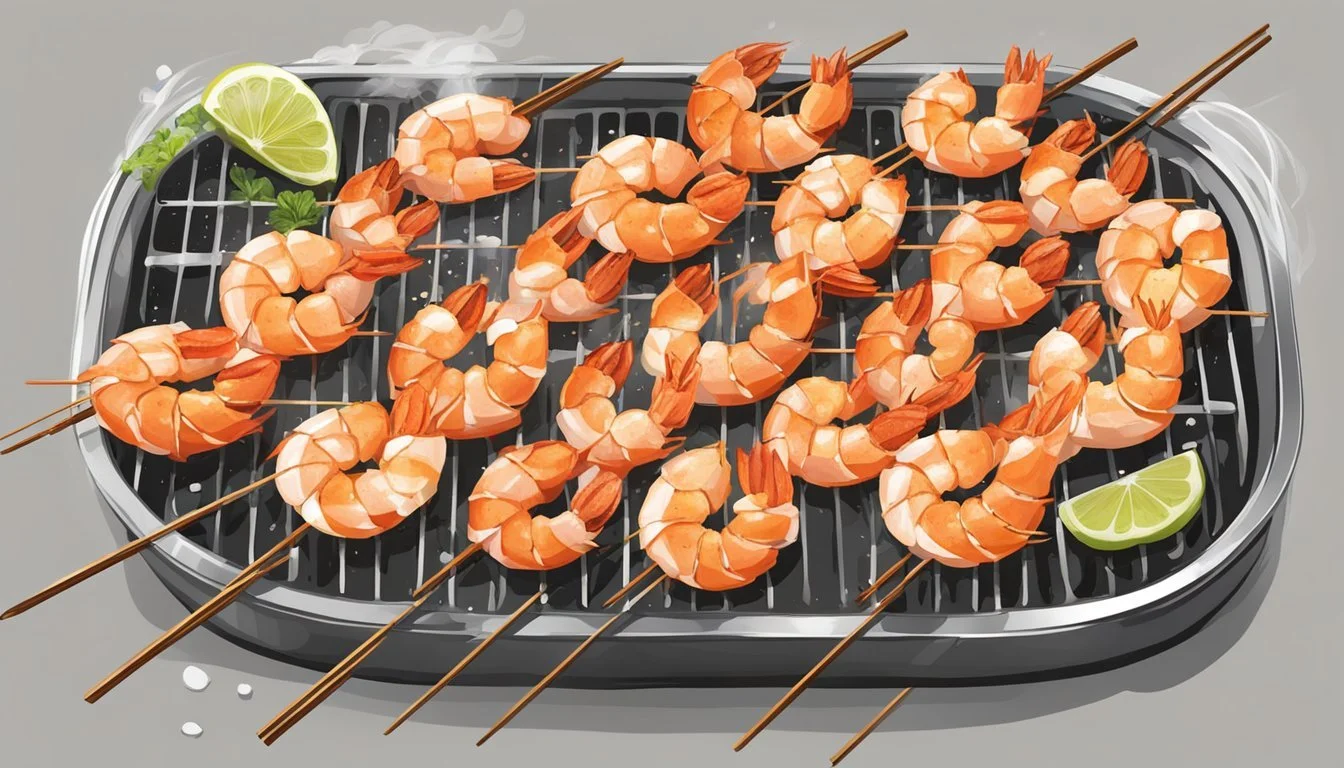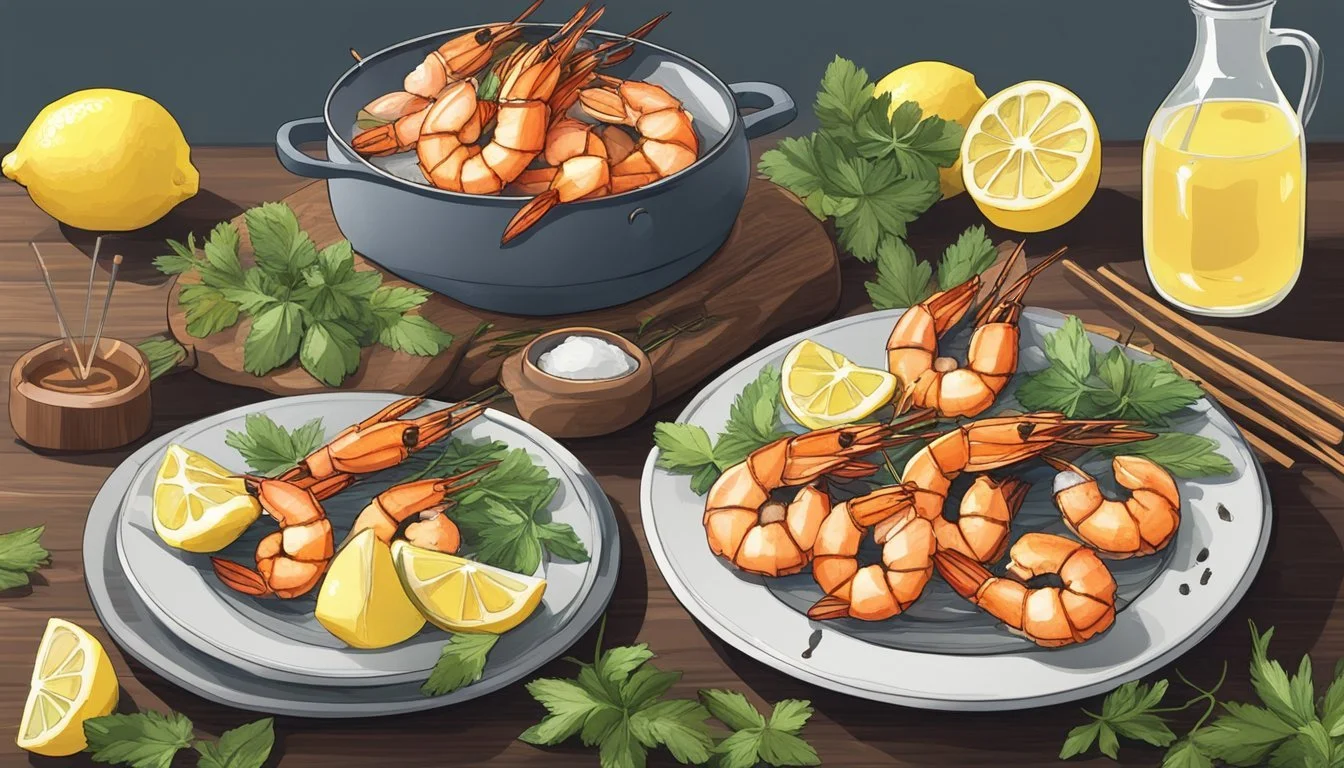Best Way to Reheat Grilled Shrimp Skewers
Ensuring Flavorful Warmth
Grilled shrimp skewers are a popular delicacy, known for their delicate texture and rich flavor. Ensuring these seafood treasures retain their succulent taste when reheated is crucial. The key lies in understanding the properties of shrimp and the factors that influence their quality upon reheating. It is important to approach reheating with a method that maintains moisture, minimizes additional cooking, and evenly warms the shrimp without drying them out.
Reheating shrimp skewers effectively requires a gentle heat and a watchful eye. Using an oven to reheat the shrimp provides a controlled environment where temperature and time can be carefully monitored. The process involves preheating the oven, arranging shrimp in a single layer, and adding a small amount of water to aid in steam generation. Covering the shrimp with foil helps to trap the steam and keeps the shrimp moist. It is recommended to reheat them for a short period, just enough to warm them through, ensuring they remain tender and flavorful.
Understanding Shrimp Reheating Fundamentals
Reheating grilled shrimp skewers properly is crucial to ensuring they retain their succulent taste and texture. The following key points will guide readers on how to maintain the shrimp's freshness and flavor during the reheating process.
Importance of Reheating Temperature
Preheating the oven or skillet is a critical step in reheating shrimp. The ideal temperature range should be low to moderate to ensure even warming without causing the shrimp to become tough or dry. Leftover shrimp reach their optimal level of warmth at roughly 275-350°F (135-177°C) in an oven or a moderately heated skillet.
Reheating in Oven: Preheat to 275-350°F (135-177°C).
Reheating in Skillet: Warm over low to medium heat.
It's also vital to consider bringing the shrimp to room temperature before reheating to shorten the required warming time and promote even heat distribution.
Retaining Shrimp Succulence
The secret to keeping reheated grilled shrimp skewers moist and flavorful lies in how they are treated during the reheating process. Adding a small amount of moisture can help: drizzle lightly with oil, or a splash of water or broth in a skillet. Covering the shrimp loosely with foil in the oven or with a lid on the skillet also helps trap steam and preserve the shrimp's natural succulence.
Use Oil: A light coating helps retain moisture.
Trap Steam: Cover shrimp with foil or a lid.
To maintain the flavors of the cooked shrimp, season modestly with salt and pepper after reheating if needed. However, be cautious not to overdo it, as shrimp are naturally salty, and extra seasoning can overshadow their delicate flavor.
Reheating Techniques and Tips
Proper reheating techniques can preserve the succulence and flavor of grilled shrimp skewers — ensuring they taste as close to freshly grilled as possible.
Oven Reheating Method
To reheat shrimp skewers in the oven:
Preheat the oven to 350°F (175°C).
Spread the shrimp in a single layer on a baking sheet.
Cover lightly with aluminum foil or parchment paper to trap moisture.
Heat for 5-10 minutes, checking for warmth without overcooking.
Tip: Do not overcrowd the baking tray to allow even reheating.
Stovetop Reheating Approach
For stovetop reheating of shrimp skewers:
Heat a non-stick skillet or frying pan over medium-low heat.
Add a small amount of olive oil or vegetable oil.
Place the shrimp skewers in the pan and heat for 2-3 minutes.
Flip occasionally, and add a splash of water if necessary to prevent drying out.
Note: The gentle heat helps retain moisture and prevents the shrimp from becoming rubbery.
Microwave Reheating Advice
While not ideal, the microwave can be used:
Remove the shrimp from the skewers and place them in a microwave-safe dish.
Cover with microwave-safe plastic wrap, puncturing a few holes for steam to escape.
Heat in 30-second intervals at 50% power, checking in between for even warmth.
Caution: Use short intervals to avoid overcooking the delicate shrimp.
Innovative Reheating Alternatives
Alternative reheating options include:
Using an air fryer to lightly reheat the shrimp skewers at 350°F for a couple of minutes.
A steamer can gently warm the shrimp skewers and maintain moisture.
Suggestion: Always monitor closely to ensure shrimp do not overcook.
Preventing Common Reheating Mistakes
Key points to avoid common mistakes when reheating shrimp skewers:
Let shrimp come to room temperature before reheating to ensure even heating.
Always add a small amount of liquid (water or broth) to replenish moisture.
Use melted butter on the stovetop for added flavor and to prevent sticking.
Reminder: Shrimp skewers should last in the fridge for up to three days for best quality.
Pairing Reheated Shrimp with Diverse Dishes
Reheated grilled shrimp skewers can be a delightful addition to various dishes, enhancing their flavor profiles while making use of tasty leftovers. When paired correctly, they bring a succulent seafood touch to the meal.
Enhancing Salads and Pasta
Reheated grilled shrimp serve as a flavorful protein option that can elevate a simple salad or pasta dish to a sumptuous meal. They are best added to:
Cold Salads: Toss the shrimp gently into green salads or Mediterranean-inspired quinoa salads for a refreshing meal.
Warm Pasta Dishes (What wine goes well with pasta dishes?): Integrate them with rich pasta sauces, such as a creamy alfredo or a tangy tomato basil, for a balanced and delicious entree.
Accompanying Fried Rice and Sandwiches
Grilled shrimp can add both texture and taste to comfort dishes like fried rice and sandwiches:
Fried Rice: Sprinkle shrimp over the fried rice, allowing them to impart a smoky flavor into each bite.
Sandwiches: Layer shrimp into a po'boy or a classic shrimp roll, making sure to balance with crisp lettuce and a zesty sauce to complement the seafood essence.
Crafting Shrimp Cocktail Variations
Shrimp cocktail is an elegant appetizer that can be reinvented with reheated grilled shrimp:
Serve the shrimp with a side of cocktail sauce for dipping, or mix into a glass layered with crisp lettuce for a twist on the classic dish.
Experiment with different sauces, such as a creamy avocado dip or a spicy sriracha mayo, to add a unique spin on this traditional seafood starter.
Proper Storage Techniques for Shrimp
Proper storage is crucial for maintaining the freshness and quality of shrimp, whether one plans to enjoy them soon after cooking or at a later time. Implementing best practices in refrigeration, freezing, and overall handling can significantly extend the edibility of shrimp.
Refrigeration Best Practices
When refrigerating cooked shrimp, they should be placed in an airtight container or wrapped tightly with plastic wrap to minimize exposure to air. Ideally, shrimp should be consumed within two days when stored in the fridge to ensure the best taste and texture. It's important to allow the shrimp to cool to room temperature before placing them in the fridge to avoid condensation within the packaging, which could accelerate spoilage.
Do:
Cool to room temperature
Use an airtight container or plastic wrap
Consume within two days
Don't:
Leave shrimp exposed
Store warm shrimp, which causes condensation
Freezing and Thawing Procedures
To freeze shrimp, one should wrap it tightly in aluminum foil or place it in a plastic bag, ensuring all air is squeezed out before sealing. Frozen shrimp can last in the freezer for up to three months. Thawing should be done carefully to preserve the quality. A hot water bath can be detrimental and should be avoided; instead, one should opt for thawing shrimp overnight in the refrigerator or using a cold water bath, keeping the shrimp in a sealed bag for hygiene and to avoid waterlogging.
Freezing Steps:
Wrap in aluminum foil or a plastic bag
Remove air and seal tightly
Label with the date
Place in the refrigerator overnight
Use a cold water bath if quick thawing is needed
Extending Shrimp Freshness and Quality
Food safety and taste are paramount when it comes to seafood. Shrimp's freshness can be prolonged through the right balance of temperature control and minimal air exposure. If one has fresh shrimp that they intend to use shortly, it is best to store them on ice in the refrigerator and consume them within one to two days. Whether using fresh or previously frozen shrimp, reheating them in a way that does not dry them out or overcook them is key; gentle heating methods are recommended to best retain their succulent taste.
Tips for Fresh Shrimp:
Consume within one to two days
Store on ice in the refrigerator
Keep them in the coldest part of the fridge
By carefully monitoring the age and handling of shrimp, one can ensure that when the time comes, the best way to reheat shrimp involves techniques that preserve their natural moisture and flavor, keeping them tender and delicious.
Creative Ways to Repurpose Shrimp Leftovers
When it comes to shrimp leftovers, the aim is to transform them into meals that are as tantalizing as the original dish. By following the right methods, one can ensure that the shrimp's succulent taste is not only preserved but also enhanced in subsequent dishes.
Transforming into New Meals
With shrimp leftovers, the possibilities for creating new and exciting meals are plentiful. They can easily become the star of a dish with a few creative twists:
Shrimp Tacos: Tuck the shrimp into soft tortillas and pair with a tangy slaw and a drizzle of lime-infused mayonnaise for a quick yet flavorsome dinner.
Shrimp Salad: Combine the shrimp with mixed greens, a vinaigrette of olive oil and lemon, and fresh herbs for a light and satisfying meal.
Infusing Flavor into Next-Day Meals
To infuse flavor into next-day meals, consider these additions that can elevate the shrimp:
Olive Oil and Garlic: Sauté the shrimp gently in olive oil with a bit of garlic to imbue a rich aroma that complements pasta dishes or warm grain bowls.
Melted Butter and Fresh Herbs: A small amount of melted butter mixed with herbs like parsley and chives can turn leftover shrimp into a delectable topping for baked potatoes or a fresh baguette.
By treating shrimp leftovers as a base for innovation, they can be reborn into dishes that delight the palate and introduce a dash of variety to the dinner table.
Conclusion
When reheating grilled shrimp skewers, it is essential to maintain the delicate balance of flavor and texture to ensure they remain as delicious and succulent as when first prepared. Oven reheating at a low temperature is recommended to gently warm the shrimp without drying them out. Covering the shrimp in foil can help retain moisture.
Using a skillet is another effective method. A tablespoon of butter or olive oil can provide a richness to the shrimp, with a splash of water or broth helping to keep them moist. The heat should be kept at a low setting, allowing the shrimp to slowly come to the desired temperature.
Regardless of the method chosen, it is imperative to avoid overcooking to preserve the nutritional value and the natural succulence of the shrimp. Bringing leftover shrimp to room temperature before reheating can decrease the risk of overcooking.
In summary, the best way to reheat shrimp is to use a low-heat, moisture-retaining method, and not to rush the process. These methods respect the delicate nature of cooked shrimp, ensuring your reheated meal is both flavorful and textured.



